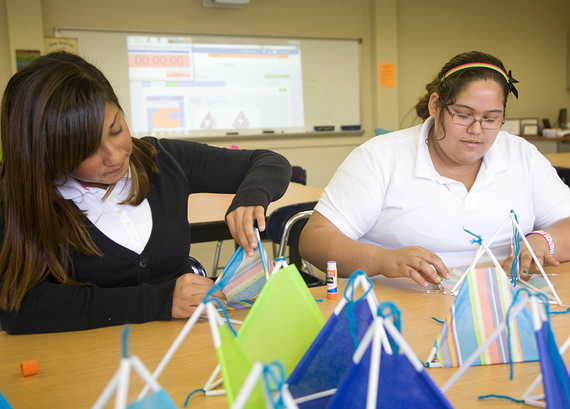On November 10, the Next Gen High School Summit will be held at the White House. President Obama is opening the White House doors to showcase extraordinary education innovation taking place across our country, and to urge more communities to bring 21st Century teaching and learning to U.S. high school students.
Events such as these make it clear that school districts and community groups can be inspired to change how schools function, based on proven models. Plenty of examples of transformed schools abound, including the nearly 200 public schools in the New Tech Network. That's the good news. The bad news is that there are no simple ways to transform schools. Defining what we want for students, aligning systems and resources to support systemic change and having state and federal policies encourage innovation are all essential for transformation. Getting to a nation proud of its education system? That means placing more trust in teachers and administrators to facilitate relevant, engaging learning and providing resources -- time and money -- to create vibrant professional learning cultures for all educators.
What's becoming clear to those in the education field is that we need to drop any notion of "teacher-proofing" a classroom, whether through pacing guides or edtech products. We have to create climates and cultures that prioritize professional learning among the adults as an ongoing focus within schools. If Deeper Learning is taking place among teachers, it will happen for students. Adult learning needs to be front and center to ensure empowered students regularly experience social learning, connect to peers and their community while also developing skills allowing them to be problem-solvers, inventors, communicators, in a word, THINKERS.
I'm excited to be invited to share our work at the White House summit, and to talk frankly about the challenges communities face while undergoing deep, systemic change to school systems. Our non-profit is proud to be partnering with school districts and charter organizations in 29 states, working with local teachers and principals to redesign the entire school experience. However, if we want this kind of teaching and learning to be the norm in our country, we need to help create vibrant education ecosystems that provide real choices to school boards, superintendents, educators and parents. We must do a better job meeting the individual needs of students, as discussed in this "Let's Get Personal" blog.
We do not need to experiment with our students. We do, however, need community support to commit to paths that turn district mission and vision statements into reality for more students in every type of community. While politics and rhetoric may vary greatly from one community to the next, our aspirations for students are strikingly alike across regions and states. We need policies that encourage and reward states and districts who embark on paths to re-imagine teaching and learning. Here are ways to support meaningful change:
- Create "innovation zones" that provide start-up funds to invest in new school models
- Designate approved school models based on evidence of success
- Waive or eliminate seat time requirements
- Include Project Based Learning as approved state professional learning standards
- Encourage formative assessment adoption; reward student and school growth through credits and waivers for educators and districts
As we shine a spotlight on innovative approaches, let's be careful not to inadvertently replace the current set of mandates and one-size-fits-all approach to classroom instruction with an updated "newer" fixed design. To truly make this a "Next Gen" effort, we'll want to create highly adaptive school structures supported by systems that use multiple forms of data to demonstrate both school and student growth, and student readiness for success after high school.
The practice of continuous improvement in transparent, open ways can become the new normal for public education, and that would be great reason to celebrate.

